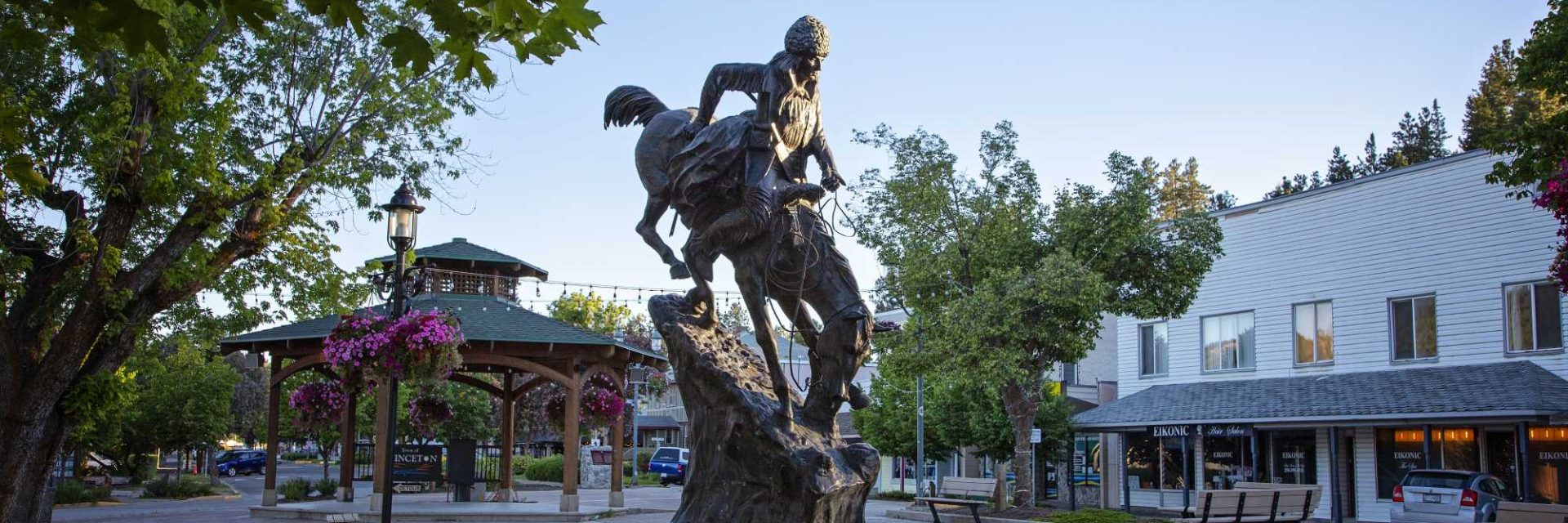A Stroll Through Art, Nature, and Community
Nestled in the heart of British Columbia’s Similkameen Valley, the town of Princeton offers more than rivers, trails, and rugged landscapes—it offers stories. And some of the most compelling ones are told not with words, but in bronze. The Princeton Bronze Sculpture Walk is a free, self-guided outdoor art experience that invites locals and visitors alike to slow down, walk the town’s core, and connect with the spirit of this land through lifelike bronze animal sculptures that echo the wild soul of the valley. Launched in 2019 as a grassroots collaboration between artists, residents, and the Town of Princeton has now created a legacy for residents and visitors alike to explore Princeton.
What is the Princeton Bronze Sculpture Walk?
The Sculpture Walk features 23 handcrafted bronze sculptures, many depicting the creatures that roam the surrounding forests, rivers, and mountains. The route winds gently through downtown Princeton, making it an engaging and interactive way to experience the town’s core on foot. From the Visitor Centre, the Bridge of Dreams, and Veterans Square, and beyond. Whether you’re visiting for the first time or know every corner of town, this walk brings fresh eyes to familiar places. You might spot a moose lounging in the grass or a bear peeking out from the side of a building. Every sculpture tells a story, and every stop is a reminder of the rich natural life that surrounds this community.
Sculptures That Speak to the Land
Princeton is the largest community in the Valley (estimated population of 3,200), and it’s located at the junction of the Similkameen and Tulameen Rivers. Recognized as the Bronze Statue Capital of Canada, discover 23 stunning life-sized statues on the Princeton walking tour.
Each sculpture along the walk has its own story to tell, not only to wildlife but to the stories and spirit of the Similkameen. Here is a list of the pieces that bring Princeton’s wild residents to life in bronze.
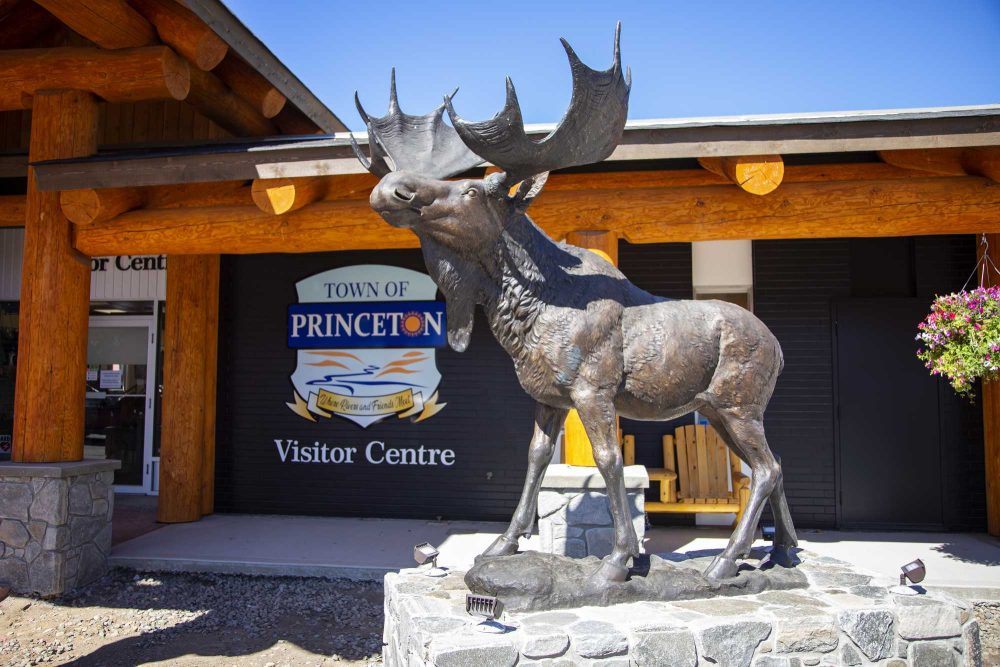
The Moose (alces alces) located at Princeton Visitor Centre: Towering, majestic, and impossible to miss—this impressive sculpture celebrates one of British Columbia’s most iconic creatures: the moose. Known for their sheer size and distinct features, including long legs, a prominent shoulder hump, and the signature flap of skin under their chin called a dewlap, moose are a symbol of the wild and rugged landscapes found throughout the Similkameen Valley.
Commonly seen in wetlands, forested areas, and willow thickets, these horse-sized animals are surprisingly solitary and are most active at dawn and dusk. While male moose are known for their massive, palm-like antlers that can span up to six feet, they are not without threats. Natural predators like bears, wolves, and humans can pose real danger, despite the moose’s imposing presence.
Located right outside the Princeton Visitor Centre, this sculpture captures the spirit and scale of the moose in remarkable detail. It’s a popular photo spot and a great place to begin your journey through the Valley.

The Cougar located at Copper Pit and Town Hall – Lean, watchful, and full of quiet intensity, this bronze cougar sculpture captures the silent strength of one of British Columbia’s most elusive predators. Positioned near Copper Pit and Town Hall, the statue is a reminder that the wild still moves through the nearby ranges.
Also known as mountain lions, cougars are the largest wild cats in Canada. Adult males can weigh well over 100 kg (220 lbs). They have sleek, light brown or tan coats, pale underbellies, and long, powerful tails used for balance and agility.
These solitary hunters are most often found in remote forests, foothills, and rugged terrain. Their diet includes deer, hares, rodents, and even insects—making them key players in maintaining ecological balance.
British Columbia is home to the world’s largest population of cougars, and the Similkameen’s untamed landscapes offer an ideal habitat for these stealthy, wide-ranging cats. This sculpture honours their quiet presence and vital role in the Valley’s natural heritage.

The Mountain Man “Trapper” located at Veterans Square – One of the most iconic pieces along Princeton’s sculpture walk, The Mountain Man pays tribute to the town’s frontier spirit and early settler history dating back to the 1860s.
Originally sculpted in 1903 by famed American artist Frederic Remington, the piece depicts an experienced Iroquois trapper skillfully guiding his horse down a steep mountain slope—a powerful image of resilience and rugged determination.
Remington (1861–1909) was a celebrated illustrator, painter, and sculptor known for capturing the essence of Western frontier life. His works often featured cowboys, Indigenous peoples, and cavalry scenes, focusing on the untamed landscapes of the American and Canadian West.
This sculpture stands not only as a nod to Princeton’s past but also as a timeless symbol of endurance, independence, and the spirit of exploration that helped shape the region.
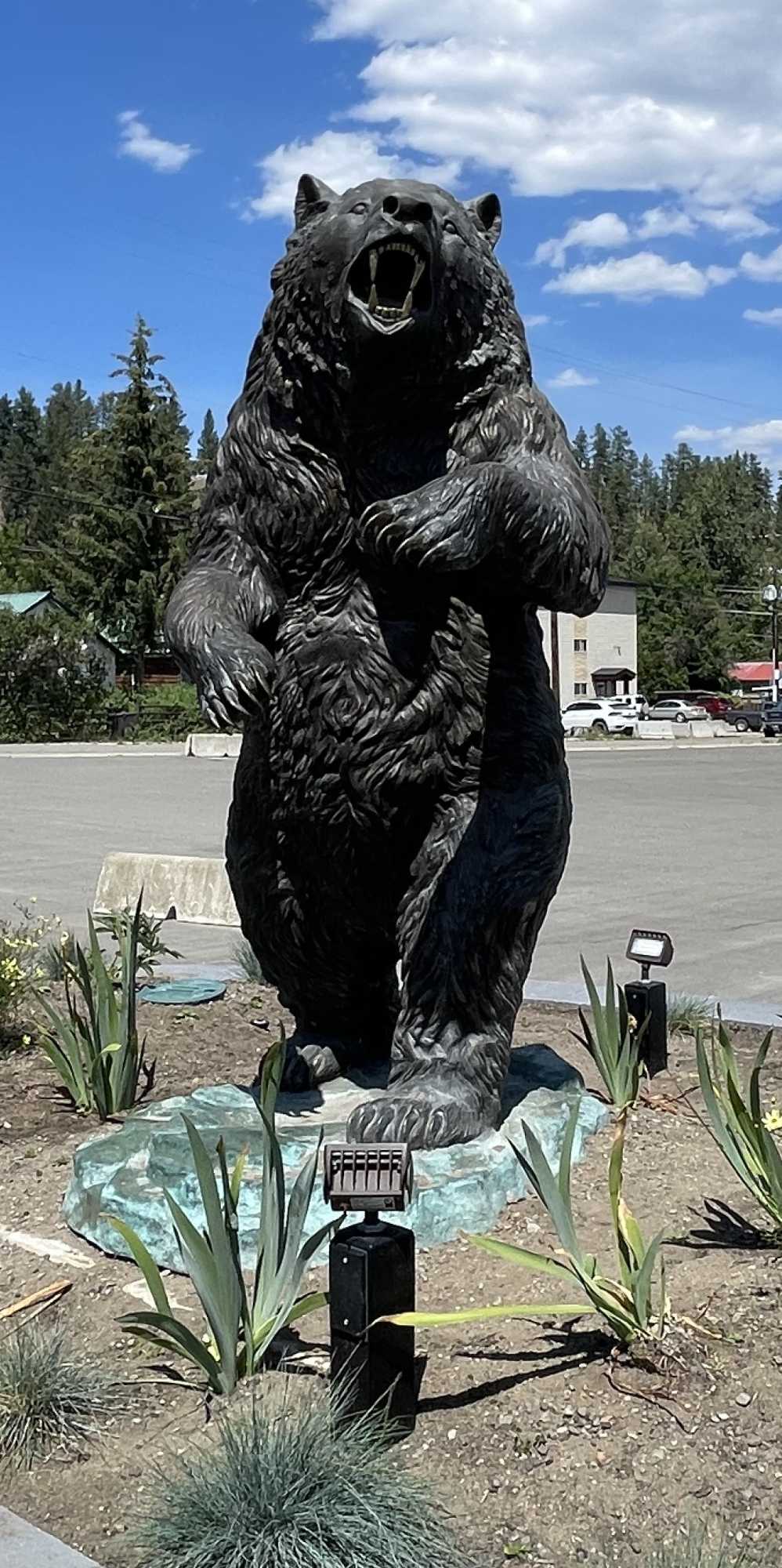
The Grizzly Bear: Located at the Bridge Street Plaza. This sculpture symbolizes the delicate balance between wilderness and human life in Princeton and the Similkameen Valley. They are often seen along the edges of forests and communities.
The grizzly is one of three bear species found in Canada, alongside the American black bear and the polar bear. British Columbia is home to roughly 15,000 grizzly bears—about one-quarter of the North American population. Grizzlies are the slowest-reproducing land mammals on the continent, and female bears are known for their fierce protection of their young.
Grizzly bears can range in colour from deep black to light blonde. Though powerful predators, they are omnivores, with vegetation making up about 70% of their diet. Their incredible sense of smell helps them locate food from great distances.
Beyond their physical presence, grizzlies play an essential ecological role and hold deep cultural significance for many Indigenous communities in British Columbia. Their survival is closely tied to the health and balance of the ecosystems they call home.
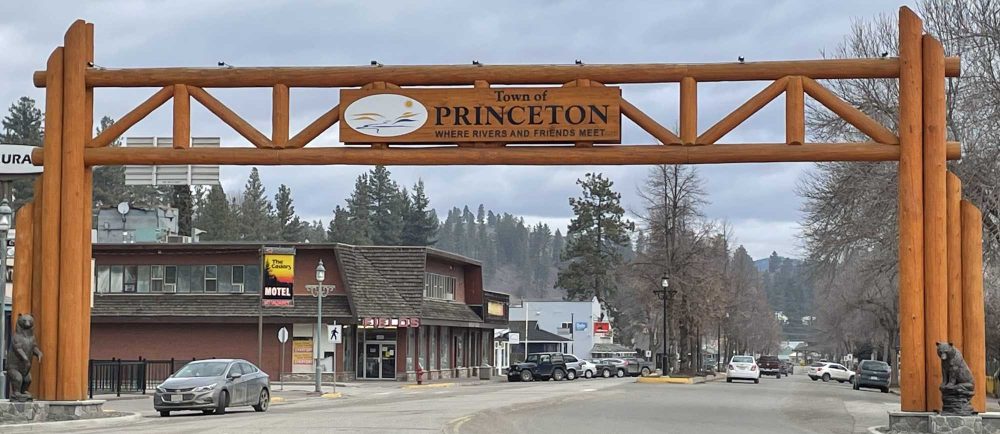
The Black Bears & Black Bear Cubs located at the Vermilion Timber Gateway – Standing proudly at the entrance to downtown Princeton, this family of black bears acts as symbolic guardians, welcoming visitors and reminding them of the wilderness that surrounds the town.
Despite their name, black bears (Ursus americanus) come in a variety of colours—from deep black to rich browns and even the rare white Kermode, or “spirit bear.” They are highly adaptable animals, capable of thriving in a range of environments throughout British Columbia.
Adult black bears can weigh over 130 kg (290 lbs), and their diet is made up of roughly 80% vegetation, including berries, grasses, and roots. They also eat rodents, insects, fish, and carrion. With an extraordinary sense of smell, they can detect food from more than a kilometre away.
Each year, black bears enter hibernation from roughly November to April. During this time, females give birth to up to five cubs, though twins are most common, and care for them for about two years before the young set off on their own.
This sculpture reflects both the strength and gentleness of the black bear, an iconic species of the Valley’s forests and a symbol of resilience, adaptability, and the wild beauty just beyond the trees.
Black Bear Cubs: Black bears are a common and captivating part of the natural landscape around Princeton. Adult females give birth to their cubs in cozy dens during the winter months, usually in January. These tiny newborns weigh just 8 ounces at birth, are blind, and rely entirely on their mother’s milk and warmth.
Cubs grow quickly; by their first birthday, many weigh close to 80 pounds. At this stage, they’re known as yearlings and are full of curiosity and energy. Young bears typically stay with their mother for about a year and a half before heading out on their own to establish their own territory, called a home range.
Whether spotted in the wild or represented in local art and storytelling, black bears are a reminder of the wilderness that surrounds Princeton and the importance of coexisting respectfully with the Valley’s wildlife.

The Bighorn Sheep – A proud symbol of the region’s rugged cliffs and resilient wildlife, this bronze statue honours the California Bighorn Sheep—an iconic species found in the steep, rocky terrain of British Columbia’s southwest interior.
This subspecies of bighorn ranges along the east side of the Coast and Cascade mountains, extending into northern California. Their name comes from the adult ram’s massive, spiraled horns, which curl back and down beside the head, then sweep forward just below the eyes. These horns grow continuously throughout the ram’s life, with visible rings—called annuli—marking each year, much like tree rings.
Rams’ horns can span up to 127 cm (50 inches) around the curve and reach a base thickness of 40 cm (16 inches), making them one of the most striking features in the animal kingdom. More than just impressive, these horns are essential tools in battles for dominance and mating rights during rutting season.
This sculpture is located by the stairs across from the Bridge Street Plaza and stands as a tribute to the bighorn’s strength, adaptability, and enduring connection to the dramatic landscapes.
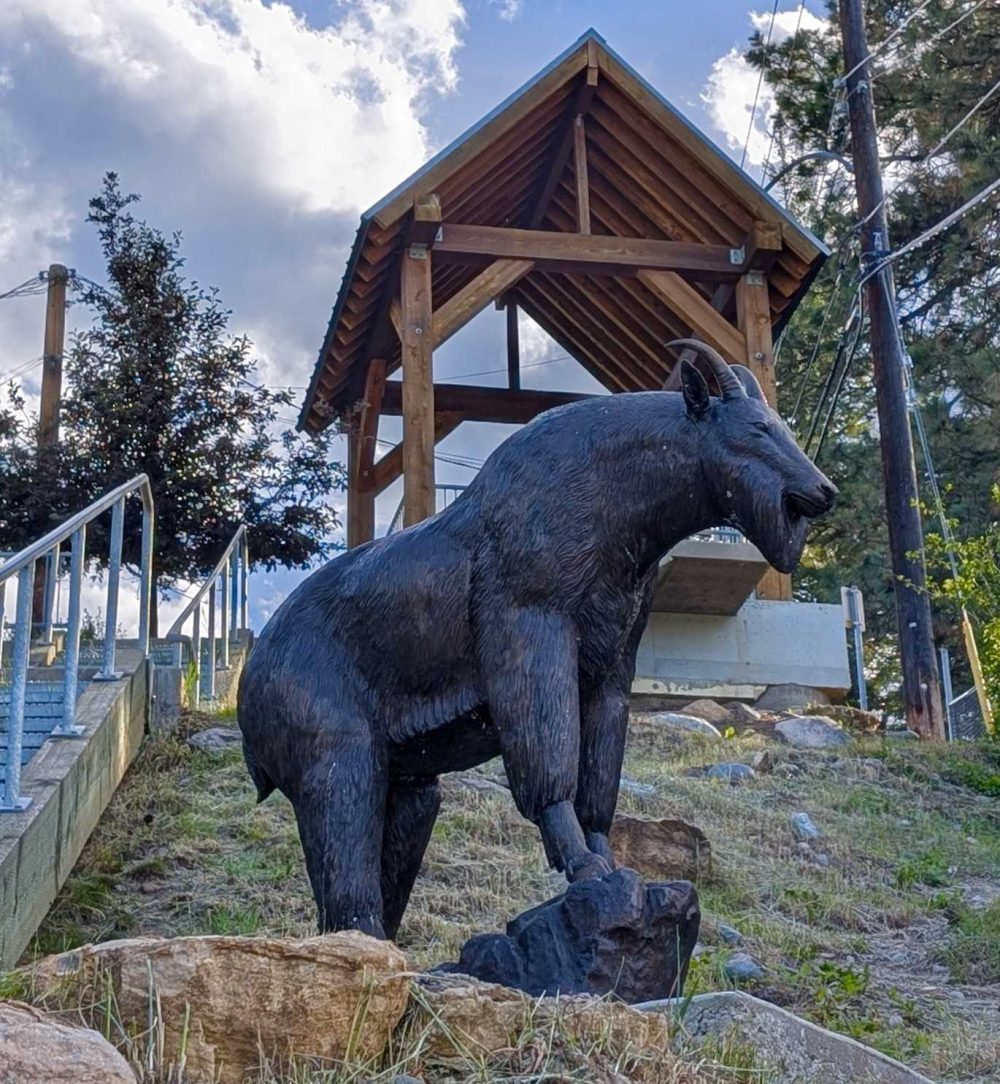
Mountain Goat Miners Climb – Also located on the stairs across from the Bridge Street Plaza, this bronze sculpture honours one of the most skilled climbers in the animal kingdom—the mountain goat. Often found on steep, rocky slopes high above the tree line, mountain goats are perfectly adapted to life in the alpine.
With their long, shaggy white coats—shed in late summer—and slender black horns, mountain goats are easy to recognize. Their specialized split hooves provide remarkable grip on narrow ledges and sheer cliffs, helping them move with surprising agility across some of the most rugged landscapes in British Columbia.
Typically most active during dawn and dusk, mountain goats thrive in terrain few others can access.
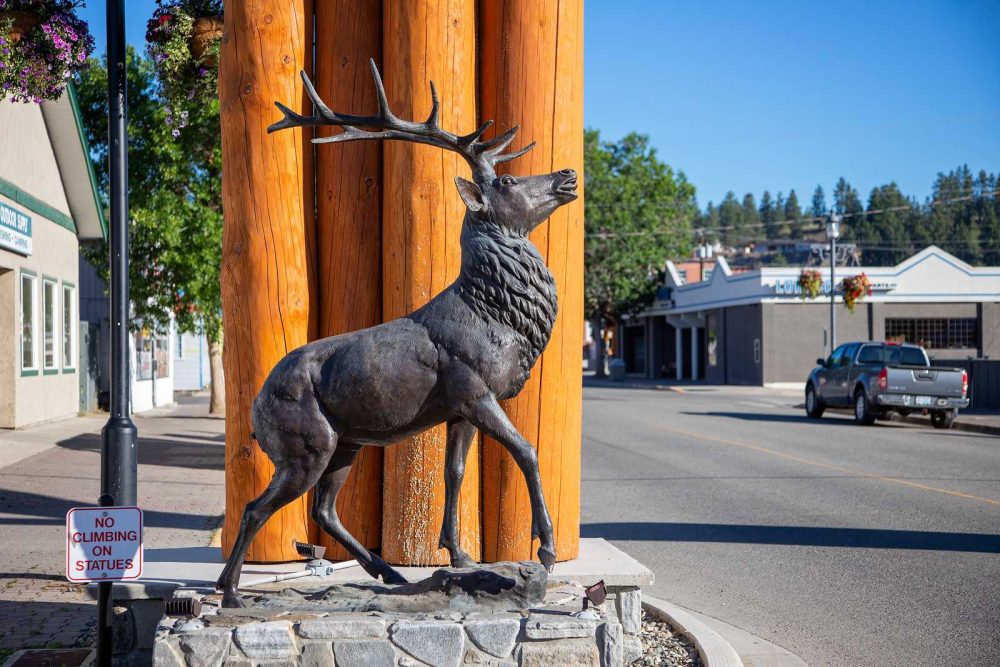
The Elk, a pair at the Bridge Street Timber Gateway – Positioned at the Bridge Street Timber Gateway, this majestic pair of elk statues marks the entrance to downtown Princeton. Representing forest-edge ecology and local biodiversity, they welcome visitors into town while nodding to the wild landscapes that surround it.
Also known as wapiti, elk are one of the largest and most prominent members of the deer family. They thrive in forested and edge habitats, grazing on grasses, leaves, lichens, and tree bark. Elk are easily identified by their long, shaggy dark necks, light-coloured rumps, and large, sweeping antlers that curve backward in a broad arc.
Females (cows) weigh between 170–290 kg (375–640 lbs), while males (bulls) can reach up to 500 kg (1,100 lbs). Their impressive size, distinctive features, and strong presence make elk a symbol of both strength and balance in nature.
These sculptures honour the role of elk in the ecosystem and invite visitors to appreciate the richness of the wildlife that calls this region home.

The Professor (Owl) – Perched atop a stack of books outside the library, The Professor symbolizes wisdom, learning, and the quiet mystery of the forest at night.
Owls are solitary, nocturnal birds known for their upright posture, broad heads, and keen binocular vision. With powerful talons and extraordinary hearing, they are silent hunters of the night—rarely seen but deeply respected in many cultures.
This sculpture captures the owl’s calm presence and watchful gaze, embodying the qualities that have made these birds a universal symbol of wisdom and quiet strength.

The Heron at the fountain– Situated atop the rock fountain near the Sunflower Gallery, this graceful heron sculpture symbolizes the rich riverside ecology and aquatic life found throughout the area.
Herons are often seen poised along riverbanks, marshes, and ponds, standing still as statues or wading slowly through the water with long, deliberate steps. While calm in appearance, they are skilled hunters capable of striking with lightning speed to catch fish.
In flight, herons are easy to spot by their long legs trailing behind and their necks tucked into a distinctive S-shape. With broad wings and deep, slow wingbeats, their silhouettes are unmistakable as they soar above the valley.
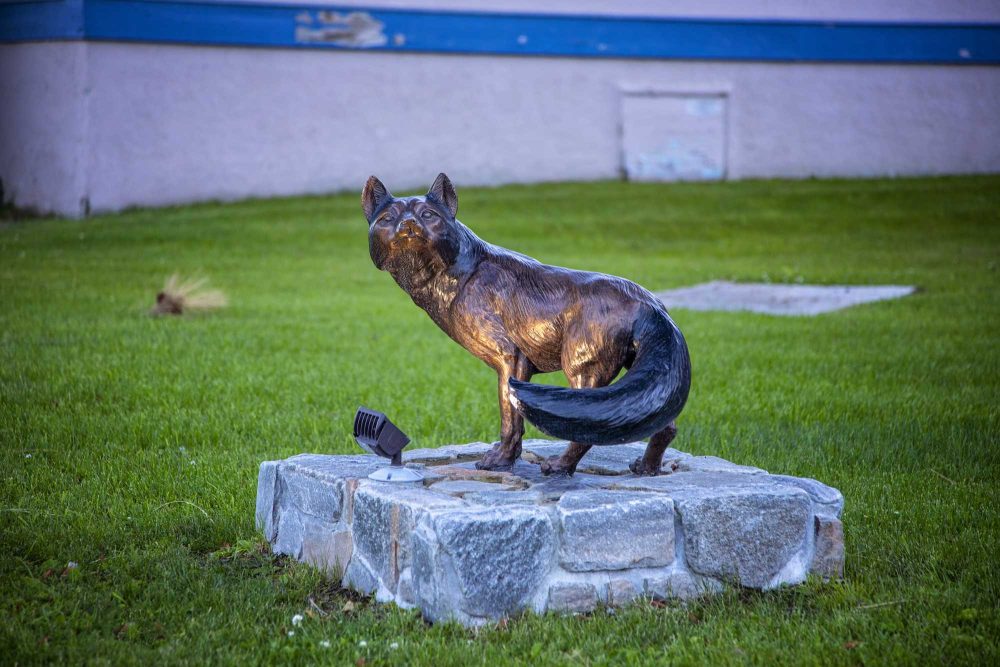
The Fox (Canis Vulpes) – This bronze fox, located near the Masonic Hall by the Princeton Museum, symbolizes intelligence, adaptability, and the often-overlooked role of smaller carnivores in the region’s natural ecosystems.
The red fox (Vulpes vulpes) is the smallest member of the canine family, which includes wolves and coyotes. Weighing between 4.5 and 9 kg (10 to 20 lbs), foxes are known not only for their cleverness but also for their impressive vocal range. Their sounds include barks, yelps, whines, growls, and even sharp, combative calls used for defense or communication.
Fox are highly adaptable and can thrive in a wide variety of environments—from forests and grasslands to deserts and mountainous terrain. They build dens (burrows) to sleep, store food, and safely raise their pups, making these shelters a vital part of their survival strategy.
Fun Fact: The grey fox, a cousin to the red fox, is one of only two canine species in the world that can climb trees!
This sculpture highlights their curious nature, quiet resilience, and important place within the diverse wildlife of Princeton and the Similkameen Valley.
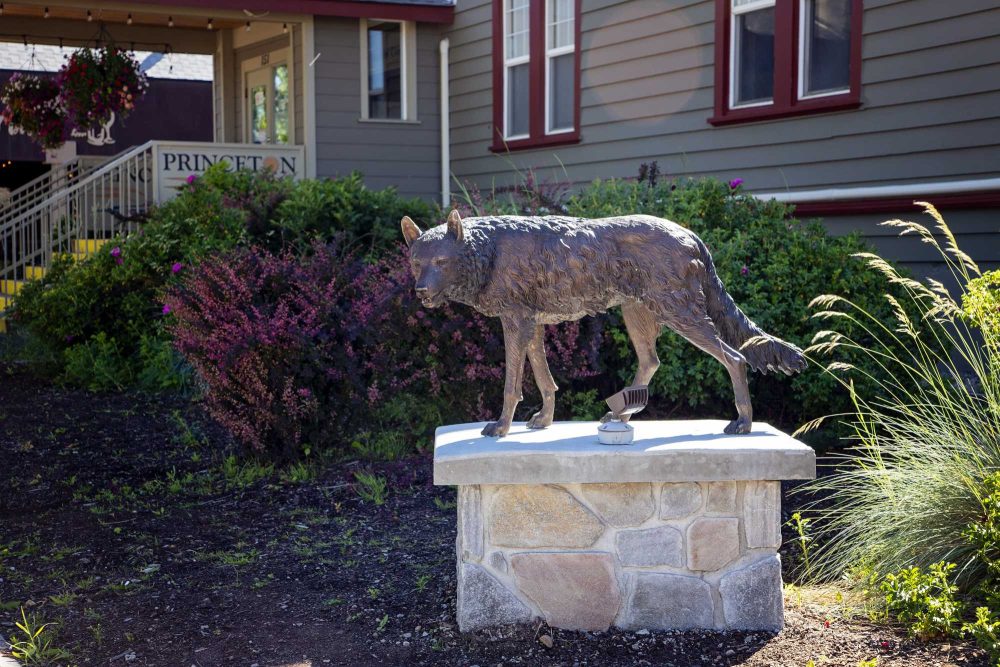
The Coyote (Canas Latrans) – Located outside Princeton’s municipal town hall, this bronze coyote represents adaptability, resilience, and the deep cultural roots of this clever creature in both natural and human-altered landscapes.
Coyotes are easily recognized by their yellow-grey coats, large ears, pointed snouts, and bushy black-tipped tails, which hang low when they run. They are often seen trotting across open fields at dawn and dusk, hunting small animals like rodents, rabbits, snakes, and birds, while also feeding on insects and berries. Adult males typically weigh between 9 and 23 kg (20–50 lbs).
Highly intelligent and adaptable, coyotes have excellent hearing and an acute sense of smell. They communicate through a wide range of vocalizations, including howls, yips, and barks.
In Syilx (Okanagan) culture, the coyote holds special significance as a central figure in oral storytelling, often portrayed as a trickster and teacher. This sculpture pays tribute to the animal’s unique role in both ecosystem and legend, reminding visitors of the close ties between culture, land, and wildlife in the Similkameen Valley.
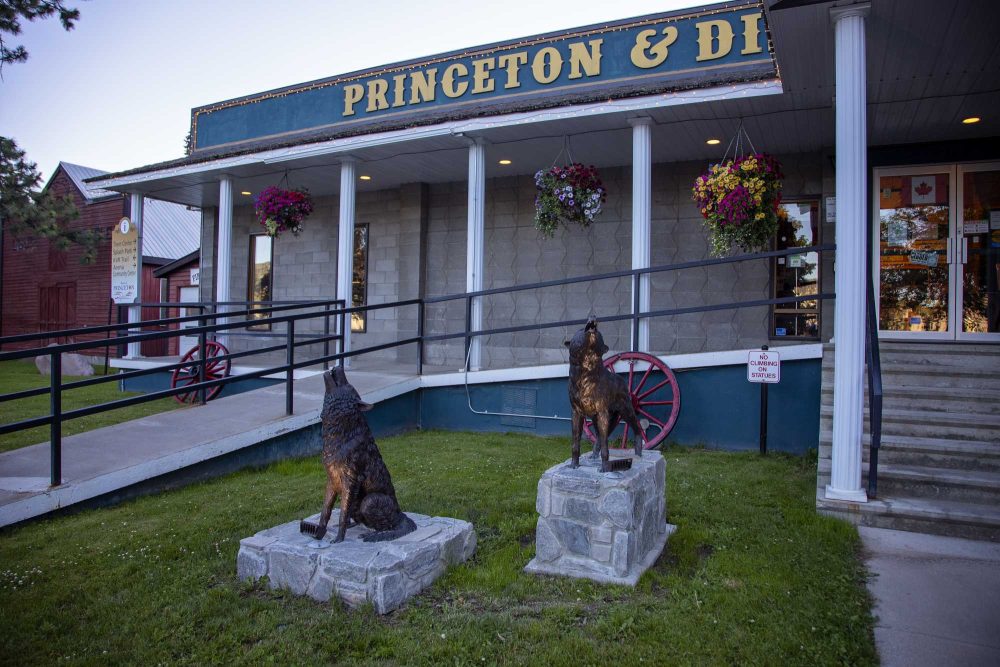
The Wolves (Canis Lupus) at the museum – Situated at the Princeton Museum, this striking bronze sculpture captures the spirit of the wolf, symbolizing wilderness, pack unity, and the critical role wolves play in maintaining ecosystem balance.
Wolves (Canis lupus) are highly social animals that live in structured packs with complex hierarchies. Known for their expressive howls, wolves use vocalizations to communicate across vast distances, while lone wolves often remain silent to avoid detection.
Larger than coyotes, wolves have broader snouts, rounder ear tips, and hold their tails high when running. Adult males typically weigh between 30–50 kg (66–110 lbs). Their thick coats range in colour from grey and white to brown and black, helping them blend into forested and tundra environments.
Wolves are skilled hunters that primarily prey on cloven-hoofed mammals such as deer and elk. As apex predators, they help keep prey populations in check, contributing to a healthier and more balanced ecosystem.

The Eagle at the Island at the end of Vermilion Ave – Poised in a place of prominence at the end of Vermilion Avenue, this bronze sculpture honours the bald eagle, an iconic symbol of strength, freedom, and ecological power in North America.
Bald eagles are striking birds of prey, easily recognized by their white heads and tails, dark brown bodies, and bright yellow beaks. With wingspans reaching up to 2.5 metres (8 feet) and weighing between 3.5 to 7 kg (8–15 lbs), they are among the continent’s largest and most powerful raptors.
Equipped with hooked beaks, strong legs, and razor-sharp talons, bald eagles are expert hunters. Their exceptional eyesight allows them to spot prey from as high as 3,000 metres (10,000 feet) in the air. During hunting dives, they can reach speeds up to 320 km/h (200 mph). Their diet consists primarily of fish but also includes small mammals and birds, often including food stolen from other animals.
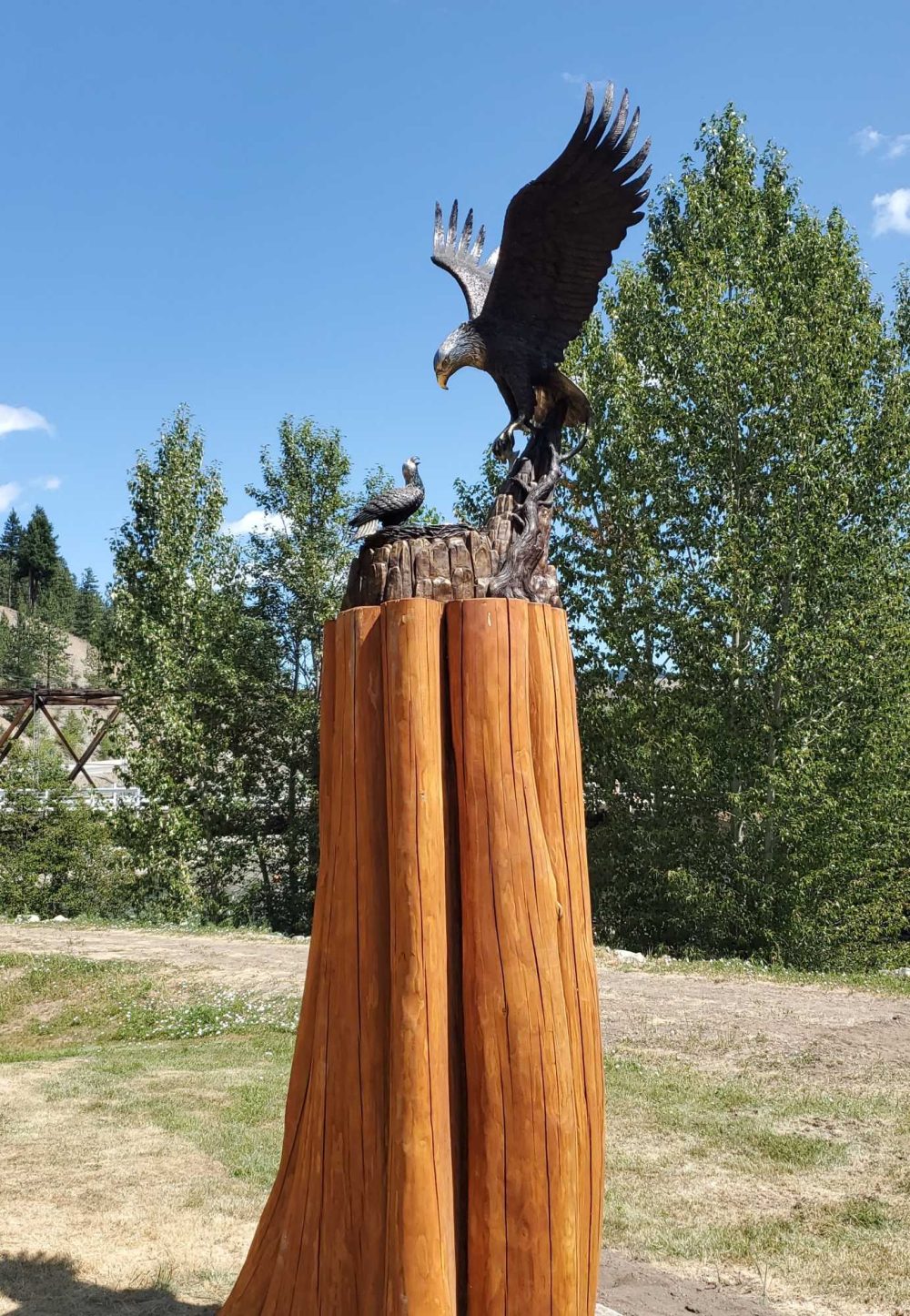
The Nesting Eagle nesting beside Brown Bridge– Located near Bridgeview Park, this bronze sculpture honours the eagle’s powerful presence in the Similkameen Valley and its important role in First Nations culture as a spiritual guardian and messenger.
Eagles are master builders, constructing some of the largest nests—called eyries—of any bird in North America. These nests are typically perched high in bare trees, on cliff edges, or even atop tall telephone poles. Over time, they can reach incredible dimensions—up to 4 metres (13 feet) deep, 2.5 metres (8 feet) wide, and weighing as much as 900 kilograms (2,000 pounds).
Most nests hold two eggs, and often the dominant chick is female, as females tend to be larger. Eagles can live 20 to 30 years, returning to the same nesting sites year after year. Their immense, carefully crafted nests are not just engineering marvels—they are essential for the survival and protection of the next generation.
This statue is a reminder of the eagle’s strength, vision, and enduring connection to the land and skies.
Altogether, the collection currently features 23 sculptures, each designed to educate, delight, and surprise. The walk continues to grow, with one to two new sculptures added each year, and exciting efforts are underway to create interactive experiences, including ways for visitors to hear the stories behind the sculptures and engage more deeply with their meaning.
Local Connection: Art Inspired by Nature
The Bronze Sculpture Walk in Princeton is a true community achievement, brought to life through the vision and support of local government, artists, and passionate residents. Shaped by the land, the wildlife, and the people who call this place home. With funding and coordination from the Town of Princeton and enthusiastic backing from local businesses and community members, this project has transformed the town’s sidewalks into a welcoming, open-air gallery.
What makes the walk so special is how it brings the natural beauty of Princeton into the heart of town. From the gentle flow of the Tulameen River to the nearby mountain ridges, each sculpture reflects the wildlife and landscape that define the region. These bronze animals aren’t just works of art; they’re ambassadors of local biodiversity and reminders of the importance of conservation and community pride.
Family-Friendly & Photo-Worthy
Perfect for all ages and accessible-friendly, the Bronze Sculpture Walk is free and can be enjoyed at your own pace. Kids love spotting the animals (like a real-life scavenger hunt), and adults will appreciate the craftsmanship and storytelling behind each piece.
Bring your camera—these sculptures are highly Instagrammable—and make it part of a bigger day out. Stop by local cafés, browse independent shops, or enjoy a picnic in one of Princeton’s parks. It’s a great mix of culture, nature, and small-town charm.
Respectful & Responsible Travel
While these bronze creatures are sturdy, they’re also works of art, so remember to look but don’t climb. Use the walk as a chance to talk with kids about wildlife respect, or to reflect on the real animals behind the art.
As you wander, consider popping into local stores, chatting with shop owners, or grabbing a bite at a family-run diner. Supporting local helps keep art and culture initiatives like this alive.
Planning your walk
The best place to begin is at the Princeton Visitor Centre (105 Hwy 3, right near the bridge). From there, you’ll find brochures, a map of the sculpture locations, and helpful tips for exploring the town on foot.
Parking is available near the Visitor Centre and along Bridge Street. The entire walk is approximately one kilometre long, flat, and fully accessible for those using wheelchairs or with mobility challenges. All sculptures can be enjoyed up close except for one, which is perched above a short staircase, but remains clearly visible from below. Most visitors complete the walk in 45 minutes to an hour, depending on their pace and the number of times they stop for photo stops.
Let the Sculptures Lead the Way
In Princeton, the sidewalks don’t just take you from point A to B; they invite you on a journey. These aren’t just sculptures, they’re storytellers in bronze, capturing the spirit of the wild and the soul of the town.
Next time you’re in Princeton, look down the sidewalk; you never know what wild friend might be waiting around the corner.
Visit our Princeton page to learn more about the town and discover all that the community has to offer.



